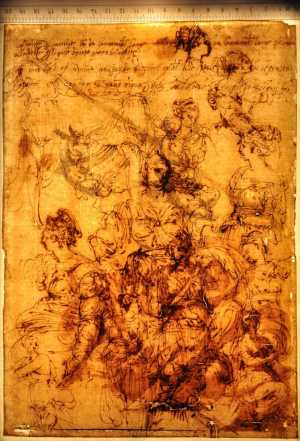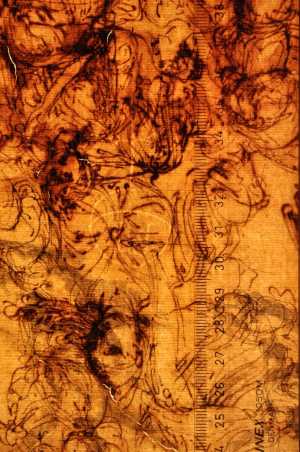Specifications
| Title | Figure Studies |
|---|---|
| Material and technique | Pen and brown ink (irongall) and grey ink, brown and grey wash |
| Object type |
Drawing
> Two-dimensional object
> Art object
|
| Location | This object is in storage |
| Dimensions |
Height 289 mm Width 205 mm |
|---|---|
| Artists |
Draughtsman:
Perino del Vaga (Piero Bonaccorsi)
Previously attributed: Anoniem Circle of: Paolo Veronese (Paolo Caliari) |
| Accession number | I 48 recto (PK) |
| Credits | Loan Stichting Museum Boijmans Van Beuningen (former Koenigs collection), 1940 |
| Department | Drawings & Prints |
| Acquisition date | 1940 |
| Creation date | in circa 1527-1541 |
| Watermark | Circle, bisected, inscribed with letters B and ?, surmounted by a Latin cross (49 x 25 mm, in the center, upside-down, on P5 of 8P, vH), similar to Briquet 2972 (larger and without inscribed letters; Olmütz 1566), no similar type in Piccard Online [see image] |
| Inscriptions | 'nolvoglire el camice che da lamanicha larga metilo indosso poi alza lamanicha larga esolivala / allaspalla allargala dirinto e fara bofurdore / cossì fato co[n] ditto camice appun[n]tarla dita manicha alla spalla diqua e dila co[n] grazia / fasamo cossì apu[n]tar u[n] pan[n]o diqua e dila dallaspala e fa busto e cigni fa.' (4 lines in a sixteenth-century handwriting, pen and brown ink), 'Ecelente' (below left., pen and brown ink) |
| Collector | Collector / Franz Koenigs |
| Provenance | Franz W. Koenigs (1881-1941, L.1023a), Haarlem, acquired in 1924 (Nothern-Italian, manner of Paolo Veronese); D.G. van Beuningen (1877-1955), Rotterdam, acquired with the Koenigs Collection in 1940 and donated to Stichting Museum Boijmans Van Beuningen |
| Exhibitions | Mantua 2001 |
| Research |
Show research Italian Drawings 1400-1600 |
| Literature | Mantua 2001, pp. 310-311, no. 177 |
| Material | |
| Object | |
| Technique |
Washing
> Wash
> Drawing technique
> Technique
> Material and technique
Washing
> Wash
> Drawing technique
> Technique
> Material and technique
|
| Geographical origin | Italy > Southern Europe > Europe |
| Place of manufacture | Venice > Veneto region > Italy > Southern Europe > Europe |
Do you have corrections or additional information about this work? Please, send us a message

























